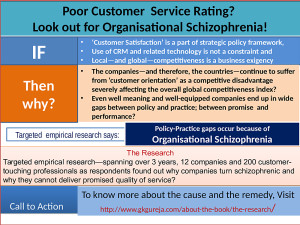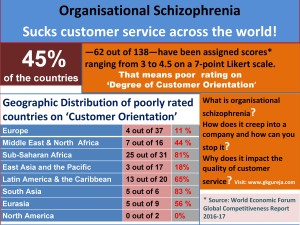Customer Orientation as Competitiveness Indicator:
‘Degree of customer orientation’ is one of the 114 indicators comprehensively studied by World Economic Forum (WEF) to arrive at a competitiveness index for each of the participating countries and to update the Global Competitiveness Report (GCR) year after year. GCR serves to provide a detailed geo-regional context for business leaders and the national governments to review their long-term competitiveness agendas. With 62 out of 138 countries getting poor rating (see infographic) it would appear that in many countries ‘customer orientation’ is not a subject of incisive discussion and meaningful follow up at the company level. This is despite the fact that most companies do consider delivering positive customer experience as a strategic operational priority.
Equipped to Deliver!
In the current age of emerging customer capitalism, it would be quite in order to imagine that many companies, across all geographical regions, can rightfully claim to have the necessary wherewithal—including unambiguous policy, stabilised processes, and emotionally engaged and professionally enabled people—to deliver promised quality of customer service. If, indeed, that is so and if a company/country wants to raise the quality of customer experience to a level of competitive advantage it must find answers to the questions raised in the following infographic and initiate the requisite corrective action.
You Have the Answers Within
It is quite reassuring that WEF’s Global Competitiveness Report has made my book ‘Organisational Schizophrenia: Impact on Customer Service Quality’ ever more relevant. There is a good reason for that.  The targeted empirical research which provided the primary resource material for this book was, indeed, triggered by the contrasting behaviour I encountered while I was trying to resolve my complaints with a number of companies, known to be highly customer focused. At the top management level it was all empathy, logic, and quick resolution of the problem. This was in stark contrast to the behaviour meted out to me at the operating level—plenty of lip service laced with evasive reasoning to outsmart the customer but no hint of any meaningful action. I found it rather intriguing and set out to find the explanation why practice was drifting away from policy. I found the answer in the companies turning schizophrenic as a result of human and organisational dynamics.
The targeted empirical research which provided the primary resource material for this book was, indeed, triggered by the contrasting behaviour I encountered while I was trying to resolve my complaints with a number of companies, known to be highly customer focused. At the top management level it was all empathy, logic, and quick resolution of the problem. This was in stark contrast to the behaviour meted out to me at the operating level—plenty of lip service laced with evasive reasoning to outsmart the customer but no hint of any meaningful action. I found it rather intriguing and set out to find the explanation why practice was drifting away from policy. I found the answer in the companies turning schizophrenic as a result of human and organisational dynamics.
Nip Cultural Fragmentation in the Bud
The research revealed that it is the ingress of self-induced cultural fragmentation or work-place schizophrenia that ends up in seriously denting the quality of customer service. The book provides answers to many questions and comprehensively deals with the reasons why such fragmentation occurs and what can management do to stem this debilitating phenomenon. To quote a global HR professor Dr. Debi Saini who reviewed the book for a well-know business school:
“It (the book) is full of insights that would be of great help to the CEOs and senior managers from HR and marketing in resolving the issues of behaviour expected by the customer. It will also help in promoting a better alignment of people strategy with business strategy. It would be of as much interest to HR professionals as it would be to marketing and sales managers and practitioners.
I am sure you will have no hesitation in recommending this book as a good read to all those who can contribute in enhancing their own and the country’s score on the ‘Degree of Customer Orientation’.
I would appreciate getting some feedback from you or your team.
*This blog is triggered by WEF Global Competitiveness Report 2016 -17.

